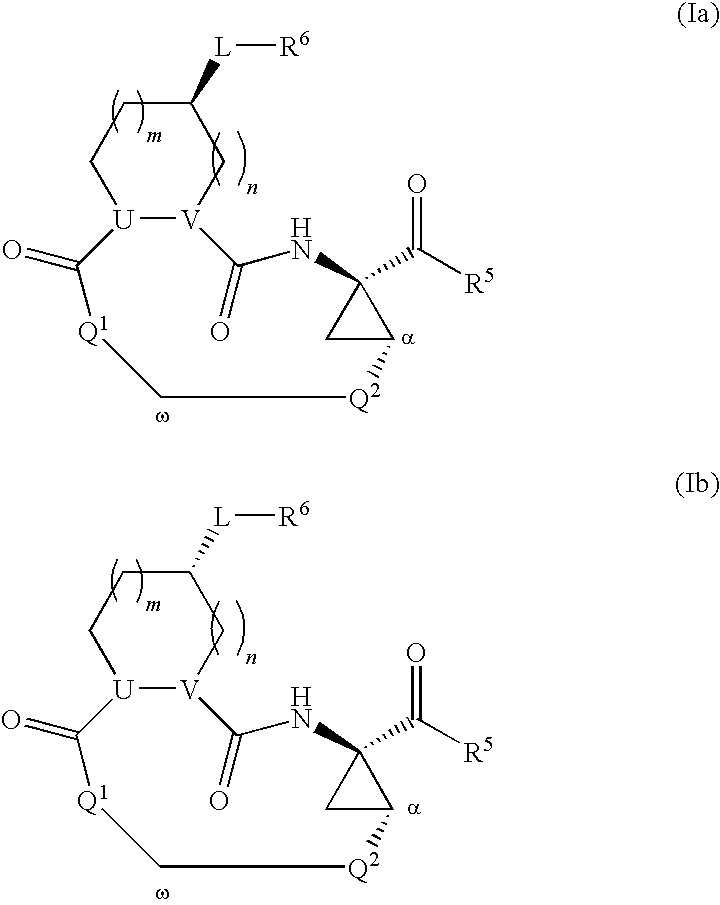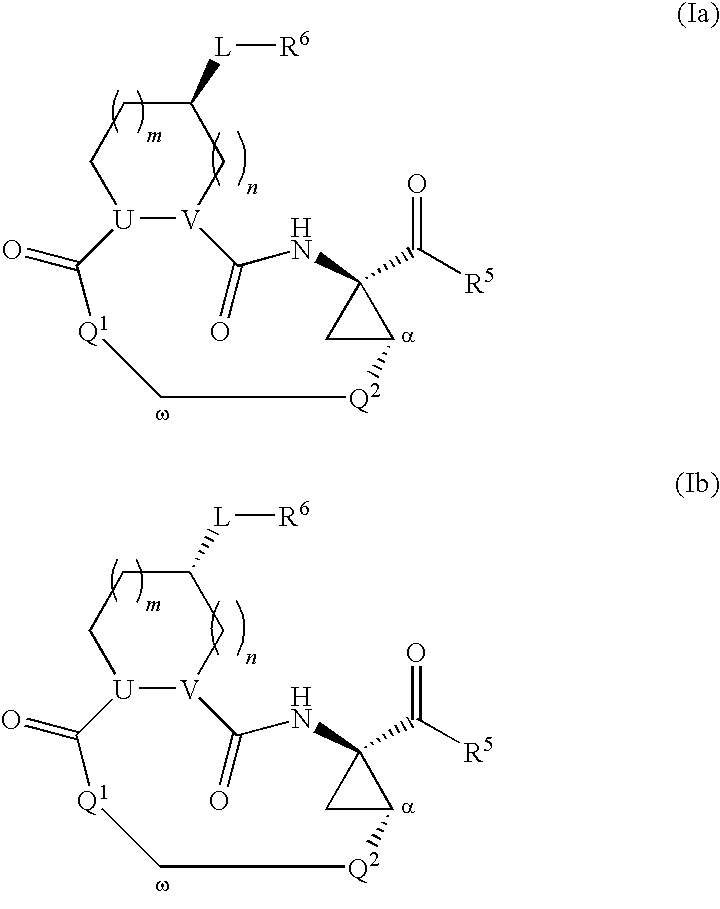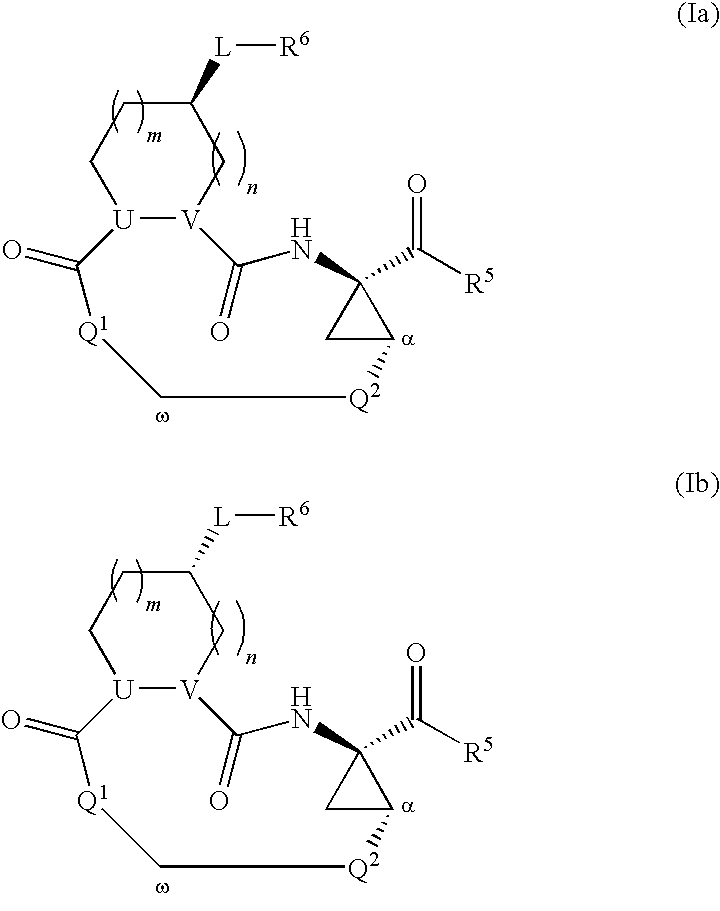Macrocyclic serine protease inhibitors
a serine protease and macrocyclic serine technology, applied in the direction of drug compositions, chemical treatment enzyme inactivation, enzymology, etc., can solve the problem that a large percentage of patients does not have a sustained reduction
- Summary
- Abstract
- Description
- Claims
- Application Information
AI Technical Summary
Benefits of technology
Problems solved by technology
Method used
Image
Examples
example 1
[0498]General procedure: Measurement of the inhibitory effect of compounds on HCV protease activity was performed with the SensoLyte™ 620 HCV Protease Assay kit from AnaSpec, Inc. (San Jose, Calif.) under conditions described by the supplier using 1.2 nM HCV NS3-NS4A protease, which was obtained according to Taremi et al. (Protein Science, 1998, 7, 2143-2149). The compounds were tested at a variety of concentrations in assay buffer containing a final DMSO concentration of 5%. Reactions were allowed to proceed for 60 min at room temperature and fluorescence measurements were recorded with a Tecan Infinity Spectrofluorimeter. The IC50 values were determined from the percent inhibition versus concentration data using a sigmoidal non-linear regression analysis based on four parameters with Tecan Magellan software.
[0499]Compound 52 was tested against genotypes 1a, 1b, 2a, 3a, and 4a of recombinant HCV NS3-4A proteases, along with other cellular proteases. The results fo...
example 2
[0502]General procedure: Huh-7 cells containing HCV Con1 subgenomic replicon (GS4.1 cells) were grown in Dulbecco's Modified Eagle Medium (DMEM) supplemented with 10% fetal bovine serum (FBS), 2 mM L-glutamine, 110 mg / L sodium pyruvate, 1× non-essential amino acids, 100 U / mL penicillin-streptomycin, and 0.5 mg / mL G418 (Invitrogen). For dose-response testing, the cells were seeded in 96-well plates at 7.5×103 cells / well in a volume of 50 μL, and incubated at 37° C. / 5% CO2. Three hours after plating, 50 μL of ten 2-fold serial dilutions of compounds (highest concentration, 75 μM) were added, and cell cultures were incubated at 37° C. / 5% CO2 in the presence of 0.5% DMSO. Alternatively, compounds were tested at a single concentration of 15 μM. In all cases, Huh-7 cells lacking the HCV replicon served as negative control. The cells were incubated in the presence of compounds for 72 hr after which they were monitored for expression of the NS4A protein by enzyme-linked im...
example 3
Generation of Recombinant JFH-1 Virus Stocks
[0509]The recombinant JFH-1 HCV virus used in the HCV in vitro infection assay was generated by transfection of HPC cells with JFH-1 RNA produced by in vitro transcription. The JFH-1 DNA template was derived synthetically using sequence information derived from NCBI Accession # AB047639 (Wakita, et al., Nat. Med. 2005, 11:791-796). Source: DNA2.0, Menlo Park, Calif.
[0510]The cDNA for the JFH-1 HCV clone was synthesized by DNA2.0 and contains a T7 promoter to drive the transcription of the JFH-1 genomic RNA. This plasmid was amplified using the Hi-Speed Plasmid Midi kit (Qiagen) according to the manufacturer's instructions.
[0511]
TABLE 2IC50EC50CC50Compound(μM)(μM)(μM)51AAC52AAC54ABD55AAC56AAD57AAC58AAC
[0512]Thirty micrograms of purified DNA was digested overnight at 37° C. with 300 U XbaI. The digested DNA served as a template for the in vitro transcription of the JFH-1 genomic RNA using the MEGAScript T7 kit (Ambion) as instructed by the m...
PUM
| Property | Measurement | Unit |
|---|---|---|
| enantiomeric excess | aaaaa | aaaaa |
| enantiomeric excess | aaaaa | aaaaa |
| enantiomeric excess | aaaaa | aaaaa |
Abstract
Description
Claims
Application Information
 Login to View More
Login to View More - R&D
- Intellectual Property
- Life Sciences
- Materials
- Tech Scout
- Unparalleled Data Quality
- Higher Quality Content
- 60% Fewer Hallucinations
Browse by: Latest US Patents, China's latest patents, Technical Efficacy Thesaurus, Application Domain, Technology Topic, Popular Technical Reports.
© 2025 PatSnap. All rights reserved.Legal|Privacy policy|Modern Slavery Act Transparency Statement|Sitemap|About US| Contact US: help@patsnap.com



